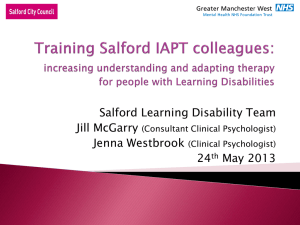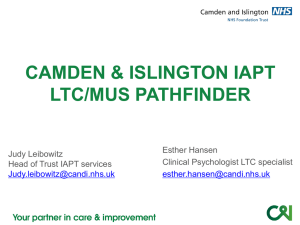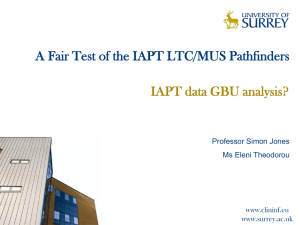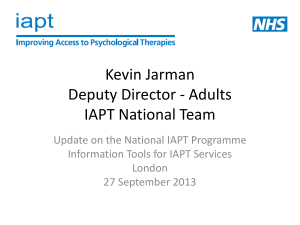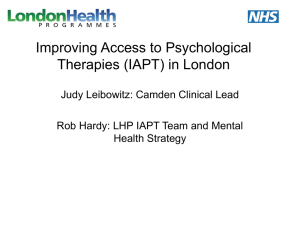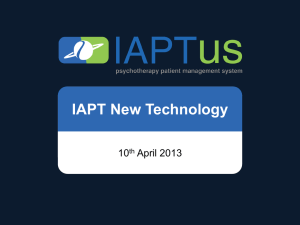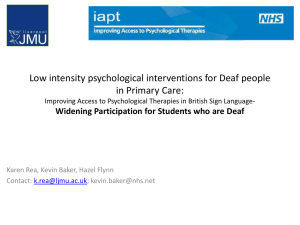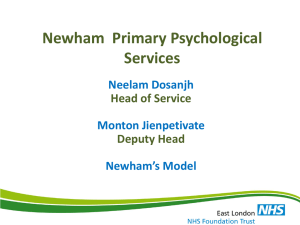here
advertisement
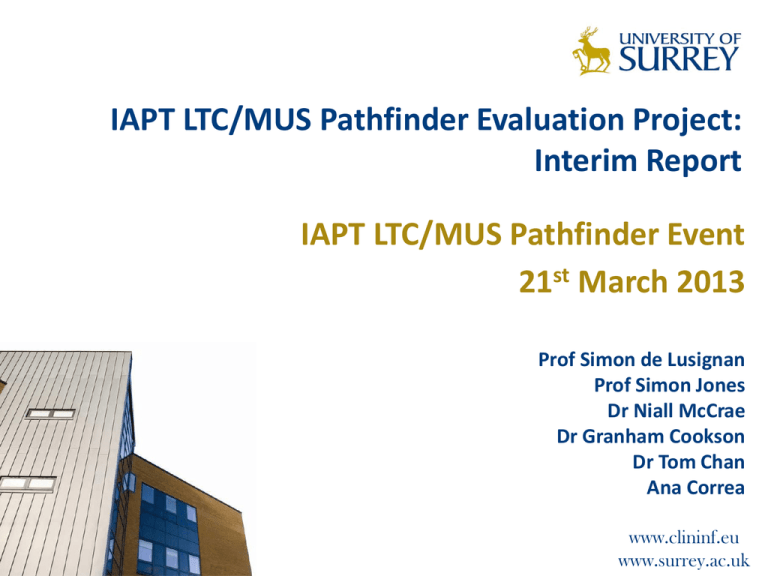
IAPT LTC/MUS Pathfinder Evaluation Project: Interim Report IAPT LTC/MUS Pathfinder Event 21st March 2013 Prof Simon de Lusignan Prof Simon Jones Dr Niall McCrae Dr Granham Cookson Dr Tom Chan Ana Correa www.clininf.eu www.surrey.ac.uk Background IAPT is designed to reduce: • Disease burden to the individual • Economic burden to the society of common mental health problems (CMHP) The costs of depression and chronic anxiety (Laylard 2006) • Lost of output (unemployment and absence from work) £12 billions • To the tax payers (benefits and lost of tax) £7 billions • Costs of a ‘proper therapy service’ – £0.6 billion www.clininf.eu www.surrey.ac.uk Pathfinder teams were tasked with identifying: • Potential optimal stepped care pathway for people with LTC/MUS • Core therapy competencies, experiences and training required to deliver therapies to people with LTC/MUS & anxiety and depression • Potential improvement in economic factors in health utilisation across primary and secondary care • Potential clinical effectiveness and improvement in condition by providing therapies to people with LTC/MUS www.clininf.eu www.surrey.ac.uk Progress to-date • Governance arrangements – – Steering Board – seeking representative from pathfinders, users and commissioning groups – Operational Team – Regular contacts/reports with DH IAPT • Evaluation plan - revised after consultation • IAPT LTC/MUS Learning events – insight into contextual information • Site visits – Piloted a info gathering schedule in Southwark & Bexley – Have visited (or arranged to visit) 5 pathfinders • Patient experience survey - Consulted DH IAPT & pathfinders – Starting survey in March 2013 • Data collection for quantitative analysis – working with DH IAPT – Local IAPT data will be linked to HES (& anonymised) by NHS IC – Designed data template www.clininf.eu www.surrey.ac.uk Revised evaluation plan: • Qualitative – site visits, discussions and available documents – Overview of services – Care pathway analysis – Workforce analysis • Quantitative – IAPT MDS, HES, & additional outcome measures – Analysis – size of services, referrals, and outcomes (e.g. changes in PHQ9 and other measures) – Economic analysis – utilisation of healthcare services, mapping W&SAS onto EQ5D • Patient experience survey – modified version of National IAPT PEQ – Survey of all new referral between Mid March to Mid-June 2013 www.clininf.eu www.surrey.ac.uk Findings and observation to-date: Source of information Routinely collected IAPT LTC/MUS data– not yet available; and site visits – not yet completed Source of information: • From the DH IAPT Team – Copies of pathfinder application – Available project administration and management records – e.g. overview of info system in use, key communications between DH and pathfinders • From the pathfinders – Presentations at learning events – Self-reported data/information – Informal discussions and e-mail correspondences www.clininf.eu www.surrey.ac.uk Findings and observation to-date: • Impressive breadth of service models • Practitioners and managers are motivated and enthusiastic about the pilot projects • Pathfinder status - gives local services space and time to apply research evidence systematically in practice across organisational boundaries (e.g. Oxfordshire Heart2heart and Buckinghamshire BreatheWell Project) • Anecdotal and documented evidence of effectiveness (e.g. Berkshire West Diabetes Project running a randomised trial; positive lient feedback in Oxfordshire and in Buckinghamshire) • Workforce competence and training – a number of pathfinders have devised training materials and self-help guides in primary and secondary care (e.g. Southwark and Bexley Pathfinder) www.clininf.eu www.surrey.ac.uk Findings and observation to-date: • • • • • Some delays in getting the pilot projects up and running Uncertainty about future funding and consequent planning Scepticism about the accuracy of CSRI Concerns about burdensome forms and measures Some data issues: – Majority use PC-MIS or IAPTus to record IAPT MDS – 5 pathfinders did not document using either system – Other measures (e.g. EQ-5D, CSRI and other conditions specific measures) are collected through local CCG supported databases or stand alone spreadsheets – Self-reported data compliance in Oct 2012 varied between 100% and 0% (2/3 reported compliance of 75% or above) – PHQ and EQ-5D scores are sometimes recorded at aggregated level www.clininf.eu www.surrey.ac.uk Conclusion and recommendations: The common themes observed – • Application of research evidence in clinical practice - ‘holistic mind and body medicine’ • Development of training programmes for practitioners and self-help guides for clients • Development of local clinical networks and integrated care pathways www.clininf.eu www.surrey.ac.uk Conclusion and recommendations: • Impressed by the innovation and commitment of the pathfinders • Holistic care – not just delivering CBT • Excellent anecdotal feedback from some clients – ‘it has changed my life’ • Certainty about Phase 2 would help • Phase 2, if supported, should mandate a more specific data template and migration of stand alone spreadsheets to a more auditable data system • Consider HES IAPT linkage as part of the routine service monitoring as an alternative to CSRI www.clininf.eu www.surrey.ac.uk Thanks for listening Contacts: - t.chan@surrey.ac.uk www.clininf.eu www.surrey.ac.uk
